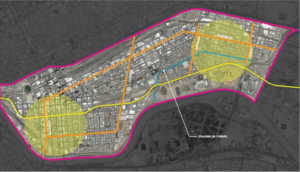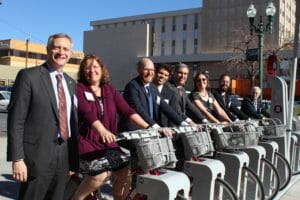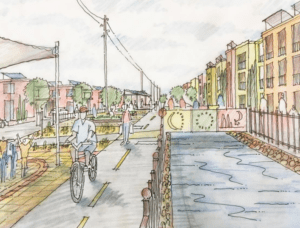Top Story
Date: November 13-18, 2016
Location: Chamizal neighborhood and downtown El Paso, Texas
Sponsor: The City of El Paso, Office Resilience and Sustainability; Borderplex Alliance; El Paso MPO; and the County of El Paso
Subject Area: Resilience, active transportation, connectivity, affordable housing, community engagement
Panel Chair: Kamuron Gurol, Former City Manager, Burien, Washington
For the panel report, please visit ULI’s Knowledge Finder
Background and Panel Assignment
 The ULI Resilience Advisory Services Panel in El Paso studied how the region’s proposed new Active Transportation System can serve as a model for resilience by taking a holistic approach to environmental planning, land use, open space, housing development strategy and civic engagement.
The ULI Resilience Advisory Services Panel in El Paso studied how the region’s proposed new Active Transportation System can serve as a model for resilience by taking a holistic approach to environmental planning, land use, open space, housing development strategy and civic engagement.
The City of El Paso faces challenges such as flash flooding, drought, water supply shortages, and urban heat island, all in conjunction with the tribulations and opportunities of sharing a significant international border with Ciudad Juárez, Mexico. Bi-national trade and travel is a day-to-day reality in El Paso and ingrained in the city’s character. El Paso’s strong identity, cohesive communities, and commitment to planning all bolster its capacity for resilience. The city has also shown its commitment to enhancing local resilience through its participation in the Rockefeller Foundation’s 100 Resilient Cities program, its investment in a Chief Resilience Officer and its development of a city-wide Resilience Strategy.
The panel paid particular attention to two specific focus areas on either end of a portion of the Active Transportation System known as the International Beltway. These two areas, downtown El Paso and the residential neighborhood of Chamizal, represent very different conditions, with downtown experiencing a recent revitalization and Chamizal housing a largely underserved, low-income community. The Active Transportation System’s International Beltway poses an opportunity to better link these communities and connect residents to jobs and economic development. Residents in these areas and throughout El Paso are also automobile dependent: 92% of El Pasoans in 2000 commuted to work by car, presenting an opportunity for the ATS to enhance connectivity and encourage bike and pedestrian trail usage.
The panel was asked to respond to the following issues:
- What Active Transportation System route between downtown and Chamizal will offer the best connectivity, access and experience for users?
- What would a resilient ATS trail look like in terms of components such as bike lanes, trees, plantings, stormwater infrastructure and pedestrian-friendly environment? How do these components respond to resource management and climate constraints and also create a more bicycle and pedestrian-friendly environment?
- How can the Salazar Park site, and others currently up for redevelopment in the study area, reflect resilient design principles, addressing climate risk, public health and active design and better incorporating open spaces and linkages to pedestrian and cycle-friendly transportation resources like ATS?
- What private and public sector funding sources can be used for resilience investments along the ATS and on sites like Salazar Park and how can interagency and public/private vehicles be involved in the delivery of resilience investments?
Summary of Recommendations
The panel’s recommendations fell into five main categories:
- Use strategies to prepare for, and adapt to, the challenges of climate change and its environmental impacts through built infrastructure, innovative strategies, and
programmatic means addressing the risks of drought, urban heat, and flash flooding. - Create and implement an effective and meaningful community engagement process that can be tailored to local communities and replicated along the ATS.
- Examine the options, benefits, and challenges for alternative transportation corridors and associated community spaces in the study area, such as the example options for the ATS corridor between downtown and Chamizal and a potential new multipurpose trail along the Franklin Canal.
- Make market-informed choices for future land use, employment, and housing options in the focus areas, including opportunities on the Salazar site and a potential relocation strategy for incompatible industrial uses.
- Build on the foundation and enhance partnerships and cooperation across the public sector, community and nonprofit agencies, and the private sector to implement these strategies and promote policy continuity and political alignment.

